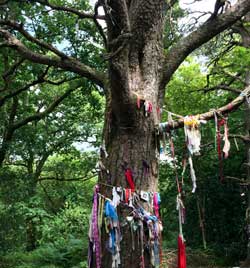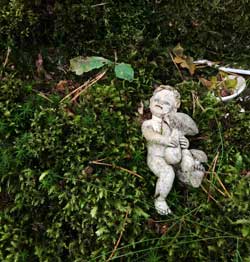AMY VAN DE CASTEELE reveals her love of fairies
When I was a little girl I believed in fairies.
I also believed in unicorns, Big Foot and extra-terrestrials, and probably a fair few other strange things besides. Fast forward nearly two decades and my interest in mysterious ape-like creatures and aliens has diminished substantially – but my fascination with fairies, unlikely as it may seem, has remained relatively undimmed.
Tolkien’s Influence
Perhaps it’s the influence of Tolkien’s remarkably finely-drawn Elven characters, perhaps it’s the impact of having visited some spectacular wild locations throughout my life – New Zealand’s South Island and the Scottish Highlands among them – but I can’t help believing in nature spirits; in natural magic. And fairies, which are essentially nature spirits after all, are a big part of natural magic. If fairy folklore is to be believed, there is a fairy in every flower and a fairy colony in every tree.

The fairies I am thinking about are not Tinkerbell incarnations, or those mischievous wee pixies which Shakespeare wrote about and Tolkien so deplored. Fairies, as I think of them, are the creatures Brian Froud brings so vividly to life in his artworks – beautiful, strange, sometimes grotesque beings, which blend into nature so easily, we clumsy, destructive humans hardly ever see them.
The Modern Age of Technology
Admittedly, it can be difficult to believe in fairies, in a modern age of technology and machines, where such beliefs are at best scoffed at and dismissed as ‘superstition’, and at worst mark you out for incarceration in a mental institution. But some little part of me still holds out stubborn hope for their existence.
And I’m not the only one. About a year ago I bought a book called Faery Tale, written by an American woman named Signe Pike. Signe, who desperately wanted to recapture the ‘magic’ of her youth, when her late father used to tell her wonderful stories as they hiked through woodland or up mountainsides, set out on a mission to try and find some fairies for herself.
She journeyed to Mexico, the Isle of Man and Glastonbury, among other places, but she also stopped off at Aberfoyle in Scotland.
In case you are unaware, Aberfoyle was the home of a 17th century minister and folklorist, Robert Kirk, who wrote the famous “Secret Commonwealth of Elves, Fauns and Fairies”, which was published more than a century after his death. Supposedly the fairies were displeased by Kirk and his collection of stories about them, and when he was mysteriously found dead on Doon Hill at the age of 47 rumours began to swirl that the fairies had taken him away to Fairyland as punishment for unveiling their secrets.
Though there is a tomb in Aberfoyle Cemetery, legend has it that Kirk’s body is not buried there and his spirit is in fact incarcerated inside an ancient pine tree which stands on the top of the ‘fairy hill’.
Paying Respects

Signe Pike journeyed to the cemetery and also climbed the fairy hill to see this legendary tree, a visit which she wrote about in her book. Following in her footsteps, I too went to Aberfoyle, on a sort of ‘fairy pilgrimage’, wanting to pay my respects to Robert Kirk and also climb the hill on which he so mysteriously died.
On the day of our visit, the skies above Aberfoyle were overcast and a light drizzle fell at times, creating a suitably melancholy atmosphere for my walk up the enchanted hill. I went first to the cemetery, entering through a green painted gate and finding myself confronted by rows of orderly, obviously recent graves, some with bright clusters of flowers adorning them. I headed instinctively to the older part of the cemetery, where grass and weeds had grown up over and around the tombstones, and before long I came upon his tomb, which stood behind the old church building (now roofless). I knew it was his tomb instantly, even without reading the faded inscription, because it was covered in coins which people had left, perhaps as tribute or some form of offering. I had no coins on me but my daughter pressed a pretty white stone into my hand, so I left that instead.
Next I headed up the winding path to the summit of Doon Hill itself. First you cross a little bridge, where legend has it you may feel the weight of Kirk’s tortured soul on your back, begging you to carry him away from Fairyland and to safety. I felt no weight but as soon as I had crossed the bridge a strange sensation of dizziness overtook me. My head felt like it was stuffed full of cotton wool and my mouth was dry. I ignored it and kept walking, but the discomfort increased with each step I took up the hill.
Light-Headed
By the time I reached the summit I felt very light-headed, though the hill isn’t very high, and I wondered if I was going to faint. But the beauty of the scene distracted me – the tree, in which Kirk’s spirit is said to be entombed, was bedecked with offerings. Coloured scraps of cloth, bracelets, little bags of jewellery, photographs, cards and pieces of paper with scribbled wishes and blessings… it was breath-taking, and wonderful to see an ancient custom still being continued to this day.
I gave my daughter one of my bracelets ‘to give to the fairies’ and left one myself. We stayed there for a while, soaking up the atmosphere, before finally turning to head back down the hill. As soon as I began climbing down the feelings of dizziness and constriction passed and I felt like my normal self again. But I did notice another odd sight, trivial though it may seem – a thin branch had fallen from a tree and caught on another thin branch below it, making the perfect sign of a crucifix high on the side of the tree. Since Kirk was a minister, it was rather eerie seeing a sign of his faith formed by nature, there on the hillside.
All in all, my pilgrimage to Aberfoyle was a very enjoyable and fascinating affair, if somewhat lacking in magical activity – and fairies. Still, there is something undeniably mystical about that place, and I hope that people will continue to leave offerings to the fairies there for many years to come, if for no other reason than that it makes a beautiful and heart-warming spectacle.








